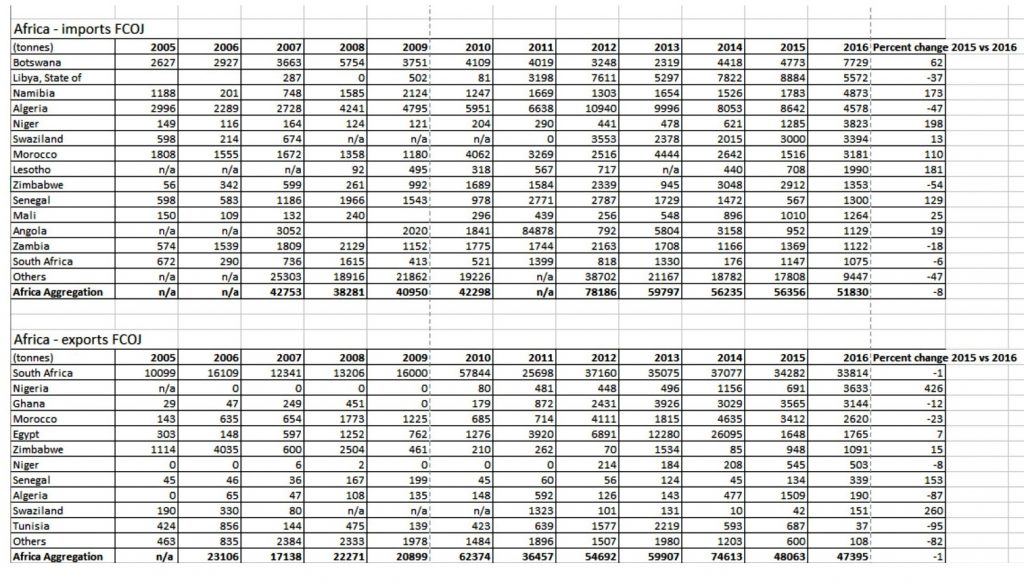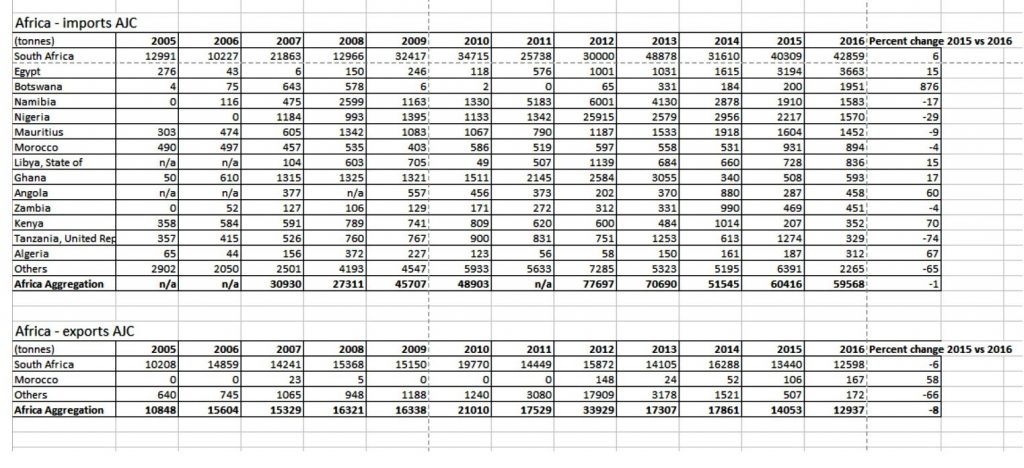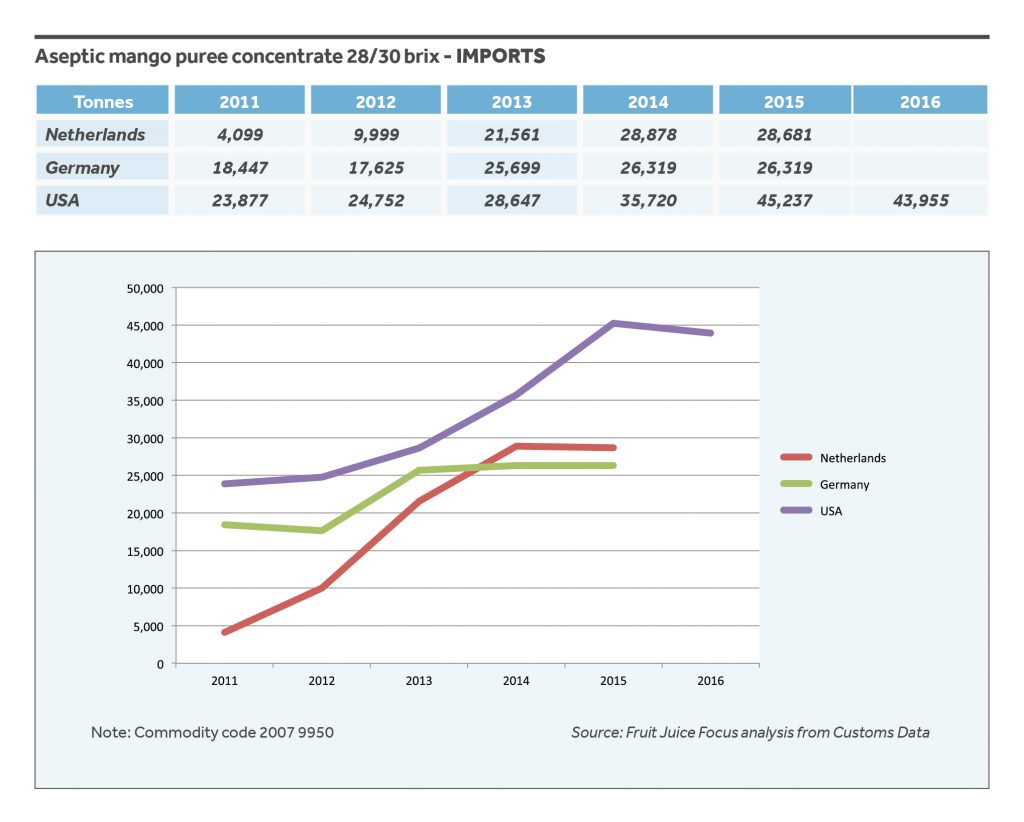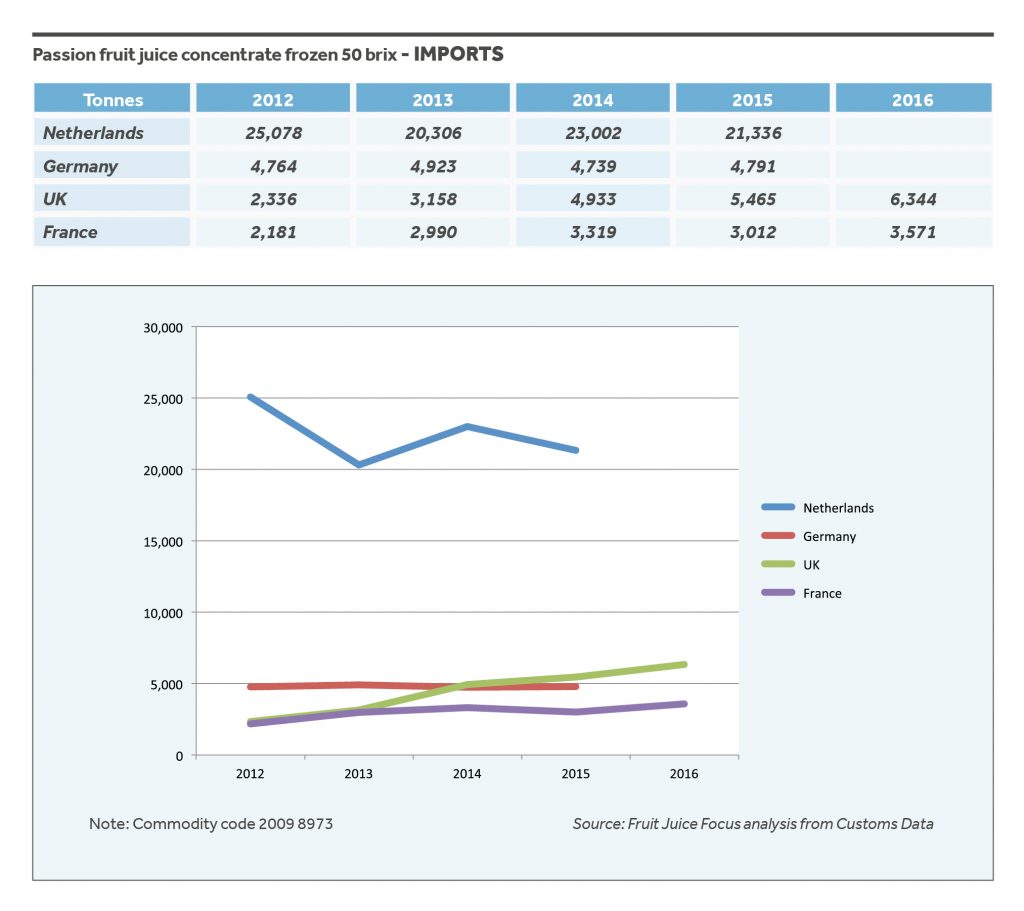BRAZIL – orange juice (CitrusBR)
As part of the Brazilian industry’s commitment to transparency CitrusBR has reported that global inventories of Brazilian orange juice (FCOJ equivalent) as of 31 December 2016 amounted to 497 383 tonnes. This is a 32% decrease on the 728 865 tonnes on hand the year before.
The association has also projected that global stock levels of Brazilian FCOJ would fall to just 70 000 tonnes on 30 June 2017. This would represent an 80% drop on the 351 567 tonnes carried into the 2016/17 crop on 30 June 2016.
BRAZIL – orange juice (Fundecitrus)
The February 2017 Fundecitrus forecast for orange production for the 2016/17 season in Brazil (São Paulo and West-Southwest Minas Gerais citrus belt) is 244 million boxes (40.8 kg) – unchanged on the December 2016 projection.
The number of fruits per box has decreased due to the increase in the weight of the fruits caused by heavy rains since December.
The average fruit droppage rate for all varieties remains at 13.73%. In the face of a small crop, the demand for fruit has boosted the harvesting pace, which has helped maintain low droppage rates.
MEXICO – Orange Juice (USDA)
Production and processing: Frozen concentrated orange juice (FCOJ) production for 2016/17 (November 2016 through October 2017) is forecast to increase with expected strong demand from processors due to attractive orange juice futures prices. Estimated 2016/17 orange juice production is 170,000 tonnes (65 brix), with production from 2015/16 revised upward to 165,000 tonnes. Deliveries to processors in 2014/15 were also revised upward. The initial forecast for fruit use by processors in 2016/17 is 1.70 million tonnes, compared with 1.60 million tonnes in 2015/16 and 1.55 million tonnes in 2014/15.
Trade: Estimated trade volume forecasts for exports of orange juice in 2016/17 are 163,000 tonnes. 2014/15 and 2015/16 estimates are revised upwards. Exports of orange juice to the US in 2016/17 are expected to be the same as in 2015/16.
SPAIN – Orange Juice (USDA)
Processing: Spain is preliminarily forecast to process 900,700 tonnes of oranges in 2016/17. This will equate to 70,000 tonnes of concentrate.
The 2015/16 crop reached 728,000 tonnes producing 56,000 tonnes of concentrate – up on the 820,000 tonnes (64,000 tonnes of concentrate) produced the previous year.
The total volume of oranges channelled to processing depends on crop quality and quantity of oranges destined for the fresh market, both domestic and foreign.
CHINA – Orange Juice (USDA)
Production: Estimated orange juice production in 2016/17 (October-September) is 42,000 tonnes, over 8% down on 2015/16.
Consumption: Forecasts for 2016/17 orange juice domestic consumption down 12% on 2015/16 at 72,700 tonnes, with demand for juice beverages losing momentum since 2014. Key industry contacts agree that although demand for juice from concentrate is falling, the market for 100% fresh orange juice is growing as cold-chain infrastructure, marketing efforts and disposable incomes expand.
Trade: With the expected drop in overall consumption, forecasts for orange juice imports in 2016/17 are 33,000 tonnes, a drop of 18% on 2015/16. Forecasts for 2016/17 orange juice exports are also down 18% on 2015/16 at 2,300 tonnes due to the anticipated lower production.
SOUTH AFRICA – Orange Juice (USDA)
Production: Orange juice production in South Africa is forecast to decrease by less than 1% to 44,465 tonnes in 2016/17 (November-October), from 44,570 tonnes in 2015/16. The 2015/16 production of orange juice was revised upwards to 44,570 tonnes. The 2014/15 production of orange juice remains unchanged at 42,163 tonnes
Consumption: Domestic uptake is expected to increase by 1% to 7,100 tonnes in 2016/17, from 7,000 tonnes in 2015/16. The 2014/15 consumption of orange juice remains unchanged at 6,800 tonnes.
Trade: 2016/17 exports of orange juice are forecast to decrease by 31% to 36,000 tonnes. The 2015/16 and 2014/15 exports of orange juice remain unchanged at 52,252 tonnes and 44,502 tonnes respectively
MOROCCO – Orange Juice (USDA)
Production: Fresh oranges delivered to juice processors are currently estimated at about 53,000 tonnes annually.
Consumption: The local market consumes more than 70% of the estimated overall orange juice production estimated at 50 million litres, of which 20 million litres come from local processing of fresh citrus and the rest from imported juice and concentrates.
Trade: Imports for 2016/17 (September – October) are forecast to increase slightly to 4,000 tonnes and exports at 3,000 tonnes. Estimated imports for 2015/16 are 3,238 tonnes and exports are 2,946 tonnes.
COSTA RICA – Orange Juice (USDA)
Trade: Costa Rica exports the majority of its orange production as frozen orange juice concentrate but also exports non-frozen juice concentrate. Exports amounted to 25,519 tonnes valued at USD37.1 million in calendar year 2015 (January-December). This compares with 29,360 tonnes valued at USD51.7 million during the same period in 2014. Data available for January-August 2016 show a significant increase in exports during 2016 reaching 34,824 tonnes valued at USD68.1 million. Higher exports during calendar year 2016 are consistent with higher production in 2015/16. The US continues to be Costa Rica’s main destination for orange juice exports.
JAPAN – Orange Juice (USDA)
Consumption: Domestic consumption for 2016/17 is forecast to decrease by 500 tonnes, a 1% decrease compared with 2015/16.
Trade: In 2015/16 total imports of orange juice decreased 15% from 2014/15 to 73,143 tonnes. This decline is attributed to large purchases made during MY
2014/15 when the price of Brazilian orange juice concentrate was low. Brazil is the largest supplier of orange juice to Japan, accounting for about 70% of Japan’s total orange juice imports. The forecast for 2016/17 estimates that total imports will increase by 9% to 80,000 tonnes
ISRAEL – Orange Juice (USDA)
Production: The initial forecast for 2016/17 (October-September) for orange deliveries to processors is 55,000 tonnes showing strong demand against the corresponding period 2015/16 which was estimated at 26,000 tonnes. The forecast for orange juice production for the period 2016/17 is 5,500 tonnes against an estimated figure of 2,600 tonnes for the same period in 2015/16.
Trade: Imports are forecast to be down year on year from 26,000 tonnes for 2016/17 against 29,000 tonnes for 2015/16. Exports are looking static for 2016/17 and 2015/16 at 14,000 tonnes and 14,400 tonnes respectively.
ARGENTINA – Lemons
Processing: Fresh lemon for processing in 2016/17 (November-October) is forecast to decrease on the previous year to 1.02 million tonnes. Fresh lemon for processing in 2015/16 is estimated to decrease from 1.2 million tonnes to 1.05 million tonnes. For 2014/2015, fresh lemon for processing remained unchanged at 1.195 million tonnes. Following the practice carried out in the past few years, relatively high volumes of fruit are being devoted for processing as a result of the decision made by the industry to export only fresh lemons meeting higher quality standards, thus restricting the export supply and preventing a steep decrease of international prices.








